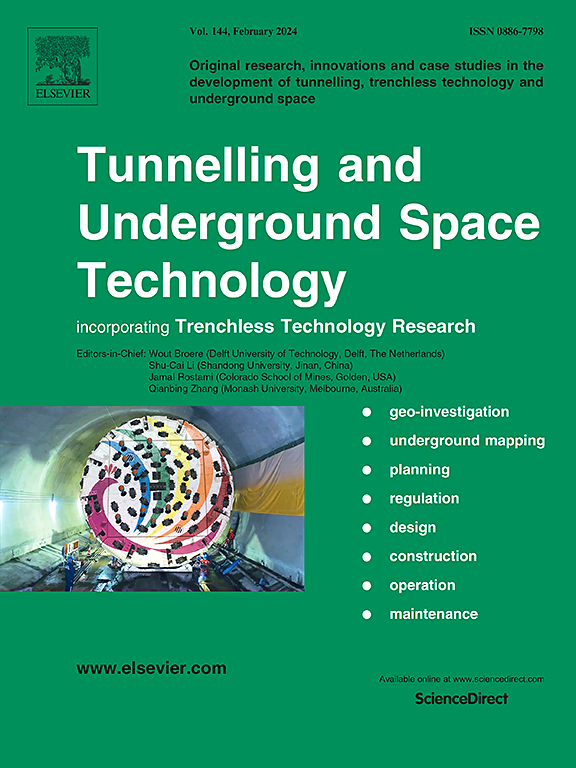CCM框架下大变形隧道中非局部损伤-塑性机制与EDZ形成的联系
IF 6.7
1区 工程技术
Q1 CONSTRUCTION & BUILDING TECHNOLOGY
引用次数: 0
摘要
岩体的大变形给深埋隧道支护设计带来了巨大的挑战。在收敛约束法(CCM)框架内准确的稳定性评估在很大程度上依赖于对岩石力学行为的适当描述。主流的塑性模型(如完全塑性、脆塑性和应变软化)不能代表固有的损伤过程,即刚度退化和裂纹扩展。为了解决这些限制,我们引入了有限应变梯度扩展损伤塑性模型,以更好地捕捉岩石在加载下的复杂行为。圆形隧道卸荷过程模拟研究:(1)损伤因素对隧道响应的影响;(2)大变形、分岔现象和网格依赖性对预测可靠性的影响。结果表明,非局部损伤塑性建模提高了CCM的预测精度,减轻了网格依赖性。基于力学机制对开挖破坏区和高度破坏区进行了较为合理的划分。从塑性主导区到损伤-塑性耦合区,最终到损伤主导区,这一渐变过程被有效地捕捉到了。由于忽略了损伤,传统的塑性模型可能低估了脆性岩石中隧道收敛的40%。该研究进一步建立了材料级损伤-塑性机制与工程级EDZ形成之间新的跨尺度相关性。这些见解促进了深埋隧道设计的预测可靠性,并为挤压地面条件下的最佳支护提供了可操作的指导。本文章由计算机程序翻译,如有差异,请以英文原文为准。
Linking nonlocal damage-plastic mechanisms to EDZ formation in large-deformation tunnels within CCM framework
Large deformations of rock masses present substantial challenges in deep tunnel support design. Accurate stability assessments within the convergence-confinement method (CCM) framework rely significantly on the appropriate characterization of rock mechanical behaviour. Mainstream plastic models (e.g., perfect plasticity, brittle-plasticity, and strain softening) fail to represent intrinsic damage processes—namely stiffness degradation and crack propagation. To address these limitations, we introduce a finite-strain gradient-extended damage-plastic model to better capture the complex behavior of rocks under loading. Simulations of the unloading process around circular tunnels address: (1) the effect of damage factors on tunnel response; and (2) the influence of large deformation, bifurcation phenomenon, and mesh dependency on predictive reliability. Results reveal that nonlocal damage-plastic modeling enhances the predictive accuracy of CCM and mitigates mesh dependency. The excavation damaged zones (EDZ) and highly damaged zone (HDZ) are partitioned more rationally based on mechanical mechanisms. The progressive transition from a plastic-dominated zone through damage-plastic-coupled zones, and eventually to the damage-dominated zone, is effectively captured. Traditional plastic models may underestimate tunnel convergence by up to 40% in brittle rocks owing to damage neglection. The study further establishes a novel cross-scale correlation between material-level damage-plastic mechanisms and engineering-scale EDZ formation. These insights facilitate the predictive reliability of deep tunneling designs and offer actionable guidance on optimal support in squeezing ground conditions.
求助全文
通过发布文献求助,成功后即可免费获取论文全文。
去求助
来源期刊

Tunnelling and Underground Space Technology
工程技术-工程:土木
CiteScore
11.90
自引率
18.80%
发文量
454
审稿时长
10.8 months
期刊介绍:
Tunnelling and Underground Space Technology is an international journal which publishes authoritative articles encompassing the development of innovative uses of underground space and the results of high quality research into improved, more cost-effective techniques for the planning, geo-investigation, design, construction, operation and maintenance of underground and earth-sheltered structures. The journal provides an effective vehicle for the improved worldwide exchange of information on developments in underground technology - and the experience gained from its use - and is strongly committed to publishing papers on the interdisciplinary aspects of creating, planning, and regulating underground space.
 求助内容:
求助内容: 应助结果提醒方式:
应助结果提醒方式:


